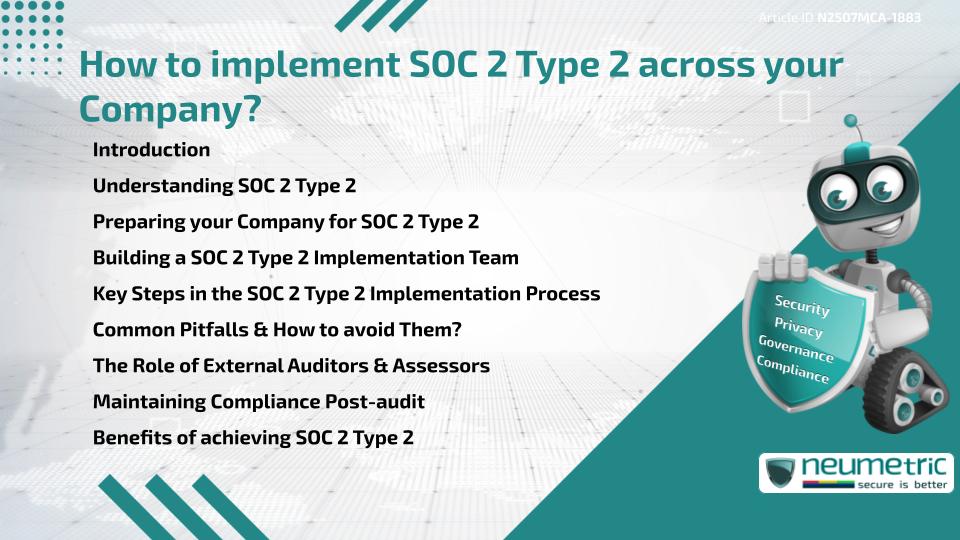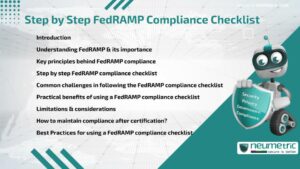Table of Contents
ToggleIntroduction
For Businesses handling Customer Data, achieving SOC 2 Type 2 Certification is not just a badge of Credibility, it’s a necessity. This Article explains How to implement SOC 2 Type 2 across your Company, covering everything from preparation & internal alignment to working with External Auditors & Maintaining ongoing Compliance. You’ll learn the essential components, challenges to expect & actionable steps to get Audit-ready across all Departments. Whether you run a Fast-growing Startup or a Well-established Enterprise, this guide breaks down the process into simple, Strategic Actions.
Understanding SOC 2 Type 2
SOC 2 Type 2 is a Security Framework developed by the American Institute of Certified Public Accountants [AICPA] focusing on How Organisations manage Customer Data based on five Trust Service Criteria: Security, Availability, Processing Integrity, Confidentiality & Privacy.
The “Type 2” part distinguishes it from “Type 1” by evaluating How well Security Controls operate over a defined time Frame-usually three (3) to twelve (12) months. It’s not about what you say you do, but about proving What you consistently have done.
This makes SOC 2 Type 2 especially valuable to Clients, Investors & Partners who want to see Long-term evidence of your Company’s Reliability & Internal Controls.
Preparing your Company for SOC 2 Type 2
Before jumping into Audits, companies need to assess their Readiness. Here are a few Preparatory actions:
- Conduct a Gap Analysis: Compare your current Security Practices with the SOC 2 criteria.
- Map Business Objectives & Customer Expectations to the five Trust Service Criteria.
- Identify Sensitive Data Flows: Understand where Data resides, How it’s accessed & who can see it.
- Document your Policies: Ensure all Security-related Procedures are written down & enforced.
Taking time to prepare upfront will save effort during the Audit Phase & Reduce the Risk of Failure.
Building a SOC 2 Type 2 Implementation Team
Implementing SOC 2 Type 2 is not a Solo activity. You need a Cross-functional Team involving:
- Executive Leadership for Strategic Alignment & Budget Allocation
- IT & Security Teams to manage Systems, Networks & Access
- Legal & Compliance for understanding Regulatory overlaps
- HR & Training Staff to handle Employee Onboarding & Security Awareness
This collaborative structure ensures each Trust Service Criterion is addressed from multiple Business angles.
Key Steps in the SOC 2 Type 2 Implementation Process
Here’s How to implement SOC 2 Type 2 across your Company in practical terms:
- Define Scope: Decide which Systems, Teams & Geographies will be Audited.
- Establish Control Objectives: Align Policies to SOC 2 Criteria.
- Implement Security Controls: These include User Access Reviews, Change Management & Incident Response.
- Deploy Monitoring Tools: Ensure you can track System Activity & Data access in Real-time.
- Create Audit Trails: Maintain Records that prove Compliance during the Observation period.
- Train Staff: Every Employee should understand their role in maintaining Security Standards.
Think of this process like installing a home Security System, not just buying the Cameras, but placing them properly, wiring them to Alarms & Checking that they actually work every day.
Common Pitfalls & How to avoid Them?
Many companies stumble during SOC 2 implementation due to:
- Over-scoping: Including too many Systems or Departments unnecessarily
- Poor Documentation: Missing Policies or Outdated Versions
- Lack of Internal Testing: Failing to validate Controls before the formal Audit
- Employee Apathy: Treating SOC 2 as IT’s job instead of a Company-wide Responsibility
Avoid these by starting small, assigning clear ownership & regularly testing your Controls before Auditors arrive.
The Role of External Auditors & Assessors
Once your Systems & Processes are aligned, you’ll work with a Licensed CPA Firm to conduct the SOC 2 Type 2 Audit. The Audit will:
- Review your Controls over a specified period
- Examine evidence of Performance
- Produce an assurance Report you can share with Clients
Auditors will expect Real-world proof like System Logs, Access Reports & Employee Training confirmations. Be Transparent & Cooperative, this relationship is based on Trust & Verification.
Maintaining Compliance Post-audit
Achieving Certification is not the end. You must sustain those same Control activities every day. Here’s How:
- Schedule Internal Reviews every Quarter
- Monitor System Logs Regularly
- Update Policies when Processes or Risks change
- Retrain Employees annually on Security Best Practices
Think of SOC 2 Type 2 as a lifestyle, not a One-time Goal. It’s about building habits that make Secure Operations second nature.
Benefits of achieving SOC 2 Type 2
When you successfully implement SOC 2 Type 2 across your Company, the benefits are Far-reaching:
- Client Confidence: A strong trust signal for Potential & Existing Customers
- Market Access: Required by many Enterprise Clients before signing Contracts
- Operational Discipline: Encourages better Documentation & Process Integrity
- Regulatory Readiness: Aligns well with other Frameworks like ISO 27001 or GDPR
Ultimately, it positions your Company as a Serious, Secure & Scalable Business Partner.
Takeaways
- SOC 2 Type 2 proves your Company maintains consistent, High-level Security Practices over time
- Implementation requires Planning, Collaboration & Disciplined execution
- Avoid common mistakes like Over-scoping or Poor Documentation
- Maintain Compliance through Continuous Monitoring & Internal Training
- Certification builds Trust with Customers & Strengthens your Company’s reputation
FAQ
What is the difference between SOC 2 Type 1 & SOC 2 Type 2?
Type 1 Reviews the design of Controls at a point in time, while Type 2 evaluates their Operational effectiveness over a period.
How long does it take to implement SOC 2 Type 2?
It typically takes between six (6) and twelve (12) months, depending on the Size & Readiness of your Company.
Do Small Businesses need SOC 2 Type 2?
Yes, if they handle Customer Data or Wish to work with Enterprise Clients that require it.
Who Conducts a SOC 2 Type 2 Audit?
Licensed CPA Firms that specialize in Auditing Security Controls for Compliance Frameworks.
Can Internal Teams perform the SOC 2 Audit?
No, only independent Auditors approved by AICPA can perform a SOC 2 Audit.
How often should SOC 2 Type 2 Audits be done?
Annually, to maintain trust & prove ongoing Control effectiveness.
What if we fail the Audit?
You won’t receive the Report. Use the Auditor’s feedback to fix the Gaps, then schedule a Re-audit.
Is SOC 2 Type 2 mandatory?
It’s not legally required but often Contractually demanded by Clients in sectors like Finance, Healthcare & SaaS.
References
- AICPA: SOC for Service Organisations
- Cloud Security Alliance: Trust Services Criteria
- Tugboat Logic: SOC 2 Guide
- Secureframe: SOC 2 Implementation
- Vanta: SOC 2 Compliance Explained
Need help for Security, Privacy, Governance & VAPT?
Neumetric provides organisations the necessary help to achieve their CyberSecurity, Compliance, Governance, Privacy, Certifications & Pentesting needs.
Organisations & Businesses, specifically those which provide SaaS & AI Solutions in the Fintech, BFSI & other regulated sectors, usually need a CyberSecurity Partner for meeting & maintaining the ongoing Security & Privacy needs & requirements of their Enterprise Clients & Privacy conscious Customers.
SOC 2, ISO 27001, ISO 42001, NIST, HIPAA, HECVAT, EU GDPR are some of the Frameworks that are served by Fusion – a SaaS, multimodular, multitenant, centralised, automated, CyberSecurity & Compliance Management System.
Neumetric also provides Expert Services for technical Security which covers VAPT for Web Applications, APIs, iOS & Android Mobile Apps, Security Testing for AWS & other Cloud Environments & Cloud Infrastructure & other similar scopes.
Reach out to us by Email or filling out the Contact Form…





